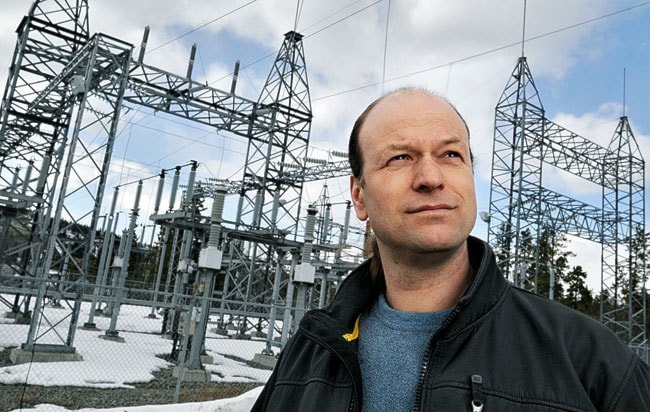Wind energy expert J.P. Pinard is hoping to use new technology to popularize an old concept here in the Yukon.
It’s called Electric Thermal Storage.
The technology has been around since the 1940s, but the idea is actually much older than that, said Pinard.
“It’s something you see in some traditional farm houses,” he said. “When the house is gone and all you see is the big rock thing that’s left behind, well that had a purpose and that purpose was storing heat.”
ETS operates on the same principle as a traditional stone hearth, but instead of fire it uses electric elements to heat up an oven full of ceramic bricks to store heat.
So far, only one Yukon home is using this technology.
Joie and Gerry Quarton replaced their old oil furnace with an ETS unit in January.
They spent a long time researching green options for replacing their aging heating system, said Joie.
It was Pinard who told them about it.
The attraction to the ETS was that it could be programmed to only draw electricity at night, during off-peak hours when the diesel generators that back up the Whitehorse hydro plant were less likely to be running.
“We just don’t contribute to burning diesel,” said Joie.
Not only does it feel good to be making a positive contribution to the environment, but the heat feels good too, she said.
“One thing is it feels really clean,” said Joie. “When you get that blast of heat with an oil furnace, just before it comes on you’re freezing, well this seems much more even.
“It’s doing a lot of computerized reading of need and it just seems to make it very comfortable.”
That’s something that Jim Deichert, the ETS division manager for the Steffes Corporation, hears all the time from customers.
The North Dakota-based company is one of the few North American manufacturers of ETS systems.
It built the furnace that the Quartons installed in their home.
Most of its sales are in regions where the local utility offers a differential rate on electricity, which makes it much cheaper during off-peak hours, said Deichert.
In those areas that offer those discounted rates - like Ontario - customers can save a whopping 50 per cent on their heating bill, he said.
Because oil and electricity are sold in such different ways, it has been hard to calculate how much of a difference it’s making, said Joie. But she thinks the operating costs are comparable.
Installing the system was a little pricier, however, because they had to hire an electrician to make some upgrades for the furnace. The unit itself was also a bit more expensive, but they got a deal on the installation because Jerry Keobke, the manager of Milligan Sheet Metal, was so excited about the concept.
“It’s a new idea for the Yukon, new idea for us,” he said.
Because the furnace contains a bunch of heavy ceramic bricks, the shipping alone was about $1,400, said Keobke.
Humping all those bricks in to the basement was the hardest part of the installation, but once they got everything else in place it was actually easier to put in than an oil-fired appliance, he said.
“I think the ETS furnace is definitely the way to go,” said Keobke, but he’s realistic about its prospects.
There has been some interest expressed from both the Champagne and Aishihik First Nations and Little Salmon/Carmacks First Nation in this technology, but until Yukon Energy starts offering a rate discount for off-peak hours, there’s no real economic incentive for installing these systems, he said.
Pinard remains hopeful however.
He first learned about ETS from his friend Dennis Meiners, who used the technology in a wind-power project in rural Alaska.
The four remote villages Meiners was working in ran primarily on diesel but had some small-scale wind turbines installed as well.
Miners, in conjunction with Steffes’ engineers, developed a computerized controller that could detect the tiny changes in frequency that happen when the turbines come online. The idea was to have the ETS heaters only charge when there was renewable energy on the grid.
That simple and easy way of storing wind energy was what got Pinard excited about the technology.
Pinard is working on a small scale 250-kilowatt wind farm with the Kluane First Nation that he hopes will allow them to displace 160,000 litres of diesel a year.
But with ETS heaters, the wind energy could be used to not only target the fuel in the diesel plant but heating oil as well, said Pinard.
He’s still trying to get funding together for that project.
Contact Josh Kerr at
joshk@yukon-news.com
